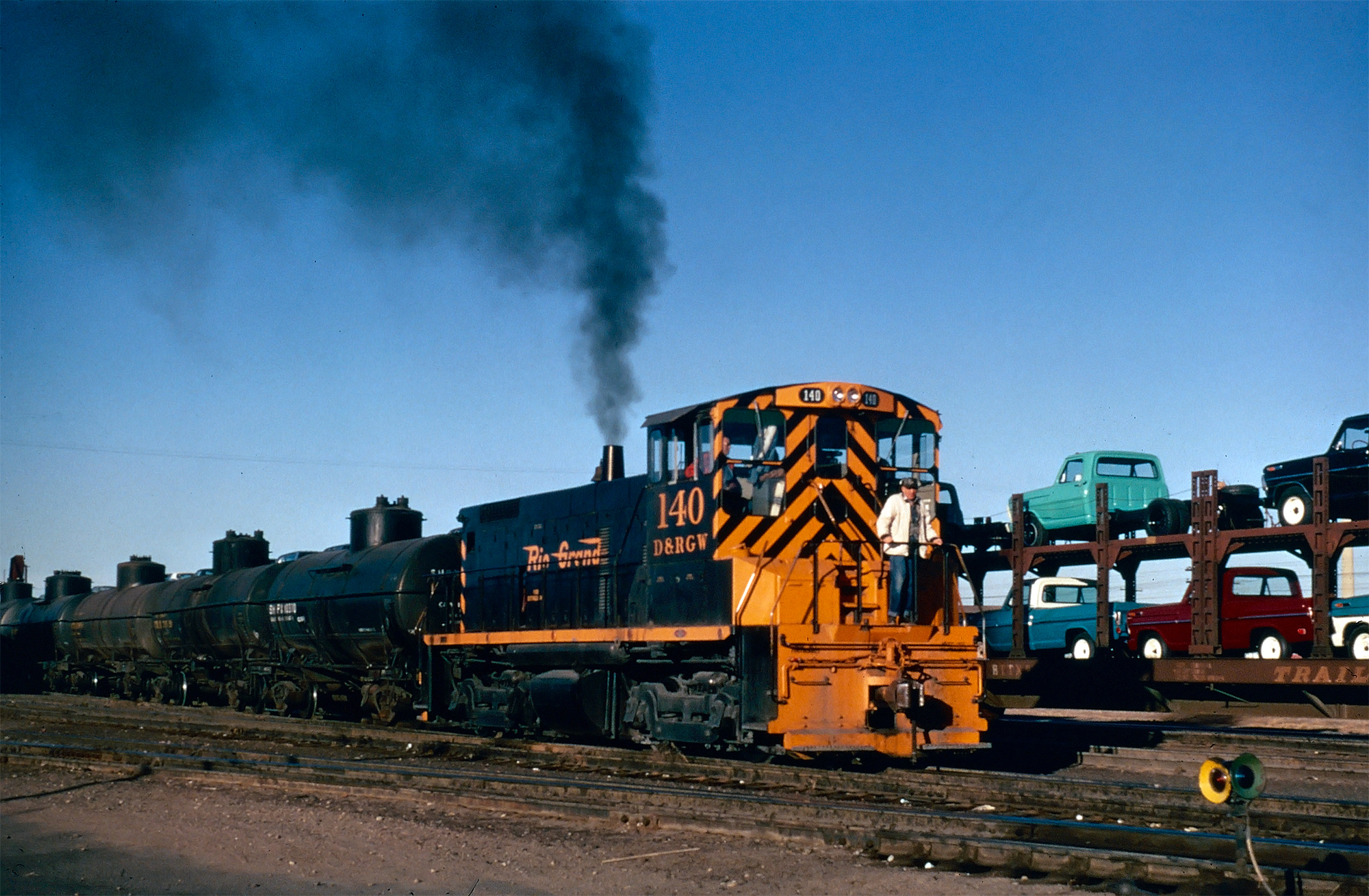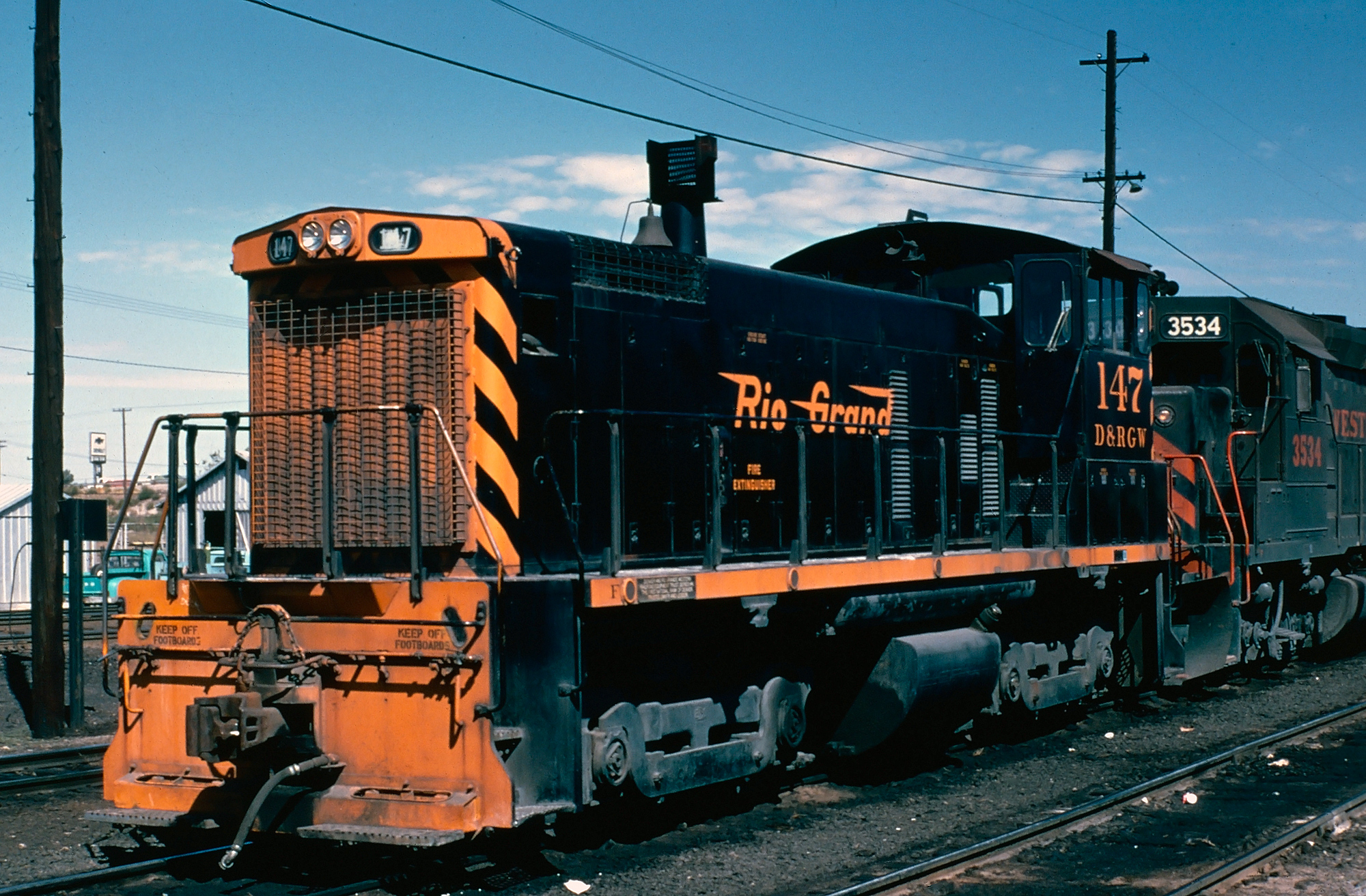EMD "SW1000" Locomotives: Data, Specs, Roster
Last revised: December 19, 2024
By: Adam Burns
The SW1000 was the first 8-cylinder model Electro-Motive offered featuring its new 645 prime mover. From a catalog standpoint, it followed the SW900, another 8-cylinder variant equipped with the earlier 567C power plant.
EMD's system for designating its switchers was not consistent, particularly in the early years, which makes deciphering each models' lettering and numbering somewhat difficult.
The SW1000 was fairly straightforward, however; the "SW" denoted it a switcher that offered 1,000 horsepower. Built during the mid-1960s, it was a second-generation variant and featured classic SW series styling.
Like the SW900, EMD found few buyers for the SW1000. Its big sister, the SW1500 saw many more sales thanks to its increased horsepower.
In any event, sales for switchers began to decline by the 1960s as lines found that their older first generation units could be reassigned to secondary and yard duty. Interestingly, despite only a little more than one hundred SW1000s, built several remain in operation on short lines and in industrial services.
Photos
 Rio Grande SW1000 #140 switches a cut of tank cars at Roper Yard in Salt Lake City, Utah, circa 1967. American-Rails.com collection.
Rio Grande SW1000 #140 switches a cut of tank cars at Roper Yard in Salt Lake City, Utah, circa 1967. American-Rails.com collection.Overview
The SW1000 began production in the summer of 1966 offering a new prime mover and slightly updated carbody. The builder stuck with the typical overall length found in earlier SW models at just over 44-feet.
It featured EMD's new model 645 prime mover (645E), an 8-cylinder engine cable of producing 1,000 horsepower.
While the switcher's taper near the cab remained, the hood featured harder lines with less beveling and a wider, boxier cab that no longer included an arched roof. It also featured a single, conical stack, the result of its 8-cylinder power plant. This feature could also be found on the SW8, SW900, SW1001, and SW600 (6 cylinder).
Reception
Once again EMD kept the model light at 115 tons. It featured General Motors' newest model D77 traction motors that could produce a respectable 36,000 pounds of continuous tractive effort and 57,500 pounds of starting effort.
Sales for the SW1000 never came around, largely due to its lower horsepower rating compared to the SW1500. The switcher was produced over a six-year period; by the time the last unit rolled out of LaGrange, Illinois in October, 1972 114 had been built with another 5 constructed for foreign companies.
Data Sheet
| Entered Production | 6/1966 (Chicago, Burlington & Quincy #9310) |
| Years Produced | 6/1966 - 10/1972 |
| EMD Class | SW1000 |
| Engine | 645E (8 Cylinder) |
| Engine Builder | EMD/GM |
| Horsepower | 1000 |
| RPM | 800 |
| Length | 44' 8" |
| Height (Top Of Rail To Top Of Cab) | 15' 0" |
| Width | 10' 3" |
| Weight | 230,000 Lbs |
| Fuel Capacity | 600 Gallons |
| Air Compressor | WXO (Gardner-Denver) |
| Air Brake Schedule | 24L (Westinghouse) |
| Trucks | B-B |
| Truck Type | GRS Rigid Bolster, Drop-Side Equalizer (AAR Type-A) |
| Truck Wheelbase | 8' 0" |
| Wheel Size | 40" |
| Traction Motors | D77 (4), EMD/GM |
| Traction Generator | D36, EMD/GM |
| Auxiliary Generator | EMD/GM |
| MU (Multiple-Unit) | Optional |
| Dynamic Brakes | No |
| Gear Ratio | 62:15 |
| Tractive Effort/Starting | 57,500 Lbs |
| Tractive Effort/Continuous | 36,000 Lbs at 11.0 mph |
| Top Speed | 65 mph |
Production Rosters
EMD
(Total Built = 114)
| Owner | Road Number | Serial Number | Order Number | Completion Date | Quantity |
|---|---|---|---|---|---|
| Chicago, Burlington & Quincy | 9310-9317 | 31696-31703 | 7879 | 6/1966-7/1966 | 8 |
| Chicago, Burlington & Quincy | 9318-9321 | 31704-31707 | 7880 | 7/1966 | 4 |
| Armco Steel | B-81 | 32087 | 4496 | 9/1966 | 1 |
| Mobile Chemical Corporation | 2 | 32160 | 4499 | 6/1966 | 1 |
| Denver & Rio Grande Western | 140-145 | 32175-32180 | 4501 | 9/1966-10/1966 | 6 |
| Detroit Edison | 216 | 32181 | 4500 | 1/1967 | 1 |
| Denver & Rio Grande Western | 146 | 32313 | 4501 | 10/1966 | 1 |
| Inland Steel | 115-116 | 32395-32396 | 4503 | 11/1966 | 2 |
| Duluth & North Eastern | 35 | 32399 | 7931 | 2/1967 | 1 |
| Cuyahoga Valley Railroad | 1050 | 32494 | 7939 | 11/1966 | 1 |
| Inland Steel | 118 | 32586 | 7941 | 2/1967 | 1 |
| Inland Steel | 117 | 32587 | 4507 | 12/1966 | 1 |
| Jones & Laughlin Steel Company | 102 | 33096 | 4513 | 6/1967 | 1 |
| Youngstown Sheet & Tube | 905 | 33121 | 4514 | 5/1967 | 1 |
| Hampton & Branchville Railroad | 120 | 33184 | 4516 | 8/1967 | 1 |
| Birmingham Southern | 10-11 | 33186-33187 | 7070 | 11/1967 | 2 |
| Youngstown Sheet & Tube | 906-907 | 33212-33213 | 4519 | 7/1967 | 2 |
| E. I. du Pont De Nemours & Company (DuPont) | 106 | 33316 | 4522 | 12/1967 | 1 |
| Wisconsin Electric Power Company | No Number | 33490 | 4526 | 8/1968 | 1 |
| Houston Belt & Terminal | 40-42 | 33522-33524 | 7078 | 1/1968 | 3 |
| E. I. du Pont De Nemours & Company (DuPont) | 107 | 33756 | 4522 | 12/1967 | 1 |
| Denver & Rio Grande Western | 147-149 | 33915-33917 | 4538 | 4/1968 | 3 |
| Public Service Company Of Indiana | 1 | 34026 | 4539 | 9/1969 | 1 |
| Youngstown Sheet & Tube | 908-909 | 34027-34028 | 4534 | 6/1968 | 2 |
| Youngstown Sheet & Tube | 910 | 34129 | 4548 | 8/1968 | 1 |
| Eastman Kodak Company | 8 | 34349 | 4551 | 12/1968 | 1 |
| Birmingham Southern | 12-13 | 34472-34473 | 7143 | 1/1969 | 2 |
| Youngstown Sheet & Tube | 911 | 34524 | 4552 | 5/1969 | 1 |
| Jones & Laughlin Steel Company | 103 | 34525 | 4553 | 2/1969 | 1 |
| Corn Products Corporation | 68-69 | 34871-34872 | 4555 | 5/1969 | 2 |
| Youngstown Sheet & Tube | 912-914 | 35041-35043 | 4559 | 5/1969 | 3 |
| Appalachian Power Company | 1 | 35830 | 4569 | 12/1969 | 1 |
| Burlington Northern | 435-449 | 35882-35896 | 4589 | 12/1970-1/1971 | 15 |
| Birmingham Southern | 14 | 35944 | 7237 | 10/1969 | 1 |
| Burlington Northern | 427-434 | 36353-36360 | 7260 | 1/1971-2/1971 | 8 |
| Birmingham Southern | 15 | 36800 | 4590 | 1/1971 | 1 |
| New Orleans Public Belt | 101-106 | 37388-37393 | 7309 | 10/1971 | 6 |
| Birmingham Southern | 16-17 | 37892-37893 | 4607 | 10/1971 | 2 |
| Burlington Northern | 375-389 | 4610-1 thru 4610-15 | 4610 | 1/1972-2/1972 | 15 |
| Great Lakes Steel | 58 | 4615-1 | 4615 | 10/1971 | 1 |
| General Motors-Central Foundry Division | No Number | 4622-1 | 4622 | 4/1972 | 1 |
| Burlington Northern | 390-394 | 4624-1 thru 4624-5 | 4624 | 10/1972 | 5 |
Export
(Total Built = 5)
| Owner | Road Number | Serial Number | Order Number | Completion Date | Quantity |
|---|---|---|---|---|---|
| Kaiser Bauxite (Jamaica) | 5109 | 32252 | 710722 | 12/1966 | 1 |
| Altos Hornos (Mexico) | 132 | 34269 | 711119 | 11/1968 | 1 |
| Cementos Anahuac Company (Mexico) | No Number | 36854 | 711771 | 9/1971 | 1 |
| Chihuahua Cellulose (Mexico) | 1811 | 37016 | 711806 | 8/1971 | 1 |
| Altos Hornos (Mexico) | 137 | 37016 | 712196 | 9/1972 | 1 |
Sources
- Foster, Gerald. A Field Guide To Trains. New York: Houghton Mifflin, 1996.
- Hayden, Bob. Diesel Locomotives: Cyclopedia, Volume 2 (Model Railroader). Milwaukee: Kalmbach Publishing Company, 1980.
- Marre, Louis A. Diesel Locomotives: The First 50 Years, A Guide To Diesels Built Before 1972. Milwaukee: Kalmbach Publishing Company, 1995.
- Marre, Louis A. and Pinkepank, Jerry A. Contemporary Diesel Spotter's Guide, The: A Comprehensive Reference Manual To Locomotives Since 1972. Milwaukee: Kalmbach Publishing Company, 1989.
- Solomon, Brian. EMD Locomotives. Minneapolis: MBI Publishing Company, 2006.
 Rio Grande SW1000 #147 and Western Pacific GP40 #3534 in Salt Lake City, Utah, circa 1975. Robert Eastwood, Jr. photo. American-Rails.com collection.
Rio Grande SW1000 #147 and Western Pacific GP40 #3534 in Salt Lake City, Utah, circa 1975. Robert Eastwood, Jr. photo. American-Rails.com collection.Interestingly, the company's Ontario plant, General Motors Diesel Division, did not take any orders for the SW1000 although the later SW1001 did see a few built in Canada.
The updated SW1001, which corrected a clearance issue over its predecessor, remained in production for nearly twenty years.
The final switcher model that proved truly successful for the company was the aforementioned SW1500, which sold nearly 1,000 examples domestically.
Additionally, EMD found quite a bit of interest with its MP15 series, the final switcher model it ever cataloged, which ended production in 1987.
Recent Articles
-
Pennsylvania - Whiskey - Train Rides
Dec 20, 25 09:06 PM
For whiskey aficionados and history buffs alike, a train ride through the Keystone State offering such spirits provides a unique and memorable experience. -
New Jersey Thomas The Train Rides
Dec 20, 25 06:32 PM
Here's a comprehensive guide to what you can expect at Day Out With Thomas events in New Jersey. -
Michigan Thomas The Train Rides
Dec 20, 25 06:28 PM
Here’s an in-depth look at what a typical "Day Out with Thomas" event in Michigan entails, what makes it special, and why it remains a must-visit for families.



